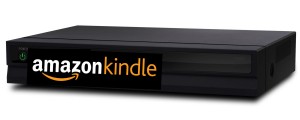I’m pretty sure the headline here says it all. Let’s review the facts (it might be worth re-reading my bit on why HBO doesn’t go direct to consumers, as many of those issues are addressed here):
- Amazon has a large content library. They are actively increasing it.
- Amazon has a content distribution platform already capable of streaming to non-PC devices.
- Amazon has a recurring billing relationship with consumers.
- Amazon has a (phenomenal) marketing and distribution channel for getting devices into consumers houses.
- Amazon has a strong brand in the hardware space.
- Amazon has the customer service & support infrastructure needed to deal with service issues.
- Amazon has the ability to build hardware and deal with supply chain issues.
- The TV services industry is huge, and Amazon wants in.
Even if they don’t plan to decouple content from Amazon Prime, making a box is a very viable, and, in my opinion, a likely move. In addition to all of the above, it is a strong move versus Apple (and possibly Google and Microsoft too).
A $99 Amazon Kindle TV box would not surprise me this coming holiday season (how about a September launch, right in time for school?). But then again, I occasionally get Kindle predictions wrong.
Oh, and one more thing. What if they do it by acquiring Roku? Let’s review that scenario:
- Roku already has something better than a minimum viable product.
- Amazon could skip all the work on developing a new UI/UX (regardless of your feelings on the Roku UX, it is well more than functional).
- Roku isn’t a sustainable business yet, enabling Amazon to purchase at a reasonable price.
- Roku has a team with a strong background and industry knowledge relevant to the TV/Device space.
- Amazon can distribute the same hardware at the same price point (which seems to fall in the not-too-profitably category), yet supplement with reliable recurring revenue.
- Amazon wouldn’t have to drop the Netflix service, but could slowly chip away at it from within.
- It’s cheaper than trying to buy Xbox from Microsoft (though that’d be quite the coup, plus nobody would even need to relocate)
I don’t really think Amazon *needs* to buy Roku, but it would probably let them fast-track a bunch of steps. And then it could be a $49 Kindle TV, which just sounds so… right.



 Every year
Every year  Whatcha Talkin Bout Willis?
Whatcha Talkin Bout Willis? Definition: For sake of discussion, I’ll define the First Age of Gadgets as starting with calculators and LCD watches (and, of course, calculator watches). Sticklers will quickly point out something I’m missing, but in my opinion that’s when the concept of “gadgets” really got kicking. These products (1) required batteries and (2) did one thing, typically pretty well. These early gadgets were typically fairly functional in nature, not very gimmicky or showy. They were also workhorses as compared to modern products – you can drop most “old school” products and not fear for significant damage (probably directly related to LED or single-line LCD outputs).
Definition: For sake of discussion, I’ll define the First Age of Gadgets as starting with calculators and LCD watches (and, of course, calculator watches). Sticklers will quickly point out something I’m missing, but in my opinion that’s when the concept of “gadgets” really got kicking. These products (1) required batteries and (2) did one thing, typically pretty well. These early gadgets were typically fairly functional in nature, not very gimmicky or showy. They were also workhorses as compared to modern products – you can drop most “old school” products and not fear for significant damage (probably directly related to LED or single-line LCD outputs). Definition: In a nutshell: USB connectivity and/or card reader integration. Slightly more detailed: the Second Age of gadgets is about products that were able to connect and/or share data with a computer (but did not include WiFi) and/or cell phones. Gadgets started becoming a little more pervasive, a little more mainstream, a lot more pop culture. In addition to the gadgets themselves, the category of gadget accessories really began to boom (chargers, carrying case, rechargeable batteries, etc). This was also the dawn of the gadget blogs. I asked Peter Rojas, founder of Gizmodo, if he could recall why he launched the site: “It was an experiment, something Nick and I started almost by accident. I don’t think either of us thought blogging would become as big as it did. People are a LOT more interested in gadgets now than when I started Gizmodo in 2002 – it’s become part of pop culture.”
Definition: In a nutshell: USB connectivity and/or card reader integration. Slightly more detailed: the Second Age of gadgets is about products that were able to connect and/or share data with a computer (but did not include WiFi) and/or cell phones. Gadgets started becoming a little more pervasive, a little more mainstream, a lot more pop culture. In addition to the gadgets themselves, the category of gadget accessories really began to boom (chargers, carrying case, rechargeable batteries, etc). This was also the dawn of the gadget blogs. I asked Peter Rojas, founder of Gizmodo, if he could recall why he launched the site: “It was an experiment, something Nick and I started almost by accident. I don’t think either of us thought blogging would become as big as it did. People are a LOT more interested in gadgets now than when I started Gizmodo in 2002 – it’s become part of pop culture.” Definition: Internet access and connectivity. Devices had either built-in Internet access, or some hybrid method of interacting with the Internet to share content, data, or services. In many cases Third Age devices are simple evolutions to their predecessors, but some innovated distinctly enough so that there’s no blurry lines. Just as the
Definition: Internet access and connectivity. Devices had either built-in Internet access, or some hybrid method of interacting with the Internet to share content, data, or services. In many cases Third Age devices are simple evolutions to their predecessors, but some innovated distinctly enough so that there’s no blurry lines. Just as the  Displays: I assume we’ll be seeing flexible display surfaces (folding, roll-up, etc) that change the way we physically interact with a device. The concept of a hard, flat screen (even a touchable one) seems very outdated to me. I think the real revolutionary tablet will be the first one with some form of flexible display (and my money’s on Apple for making this happen). I also foresee better use of microprojectors to remove the need for an on-board display at all.
Displays: I assume we’ll be seeing flexible display surfaces (folding, roll-up, etc) that change the way we physically interact with a device. The concept of a hard, flat screen (even a touchable one) seems very outdated to me. I think the real revolutionary tablet will be the first one with some form of flexible display (and my money’s on Apple for making this happen). I also foresee better use of microprojectors to remove the need for an on-board display at all.